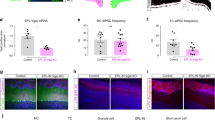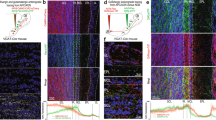Abstract
Olfactory perception is influenced by hormones. Here we report that adrenaline can directly affect the signal encoding of olfactory receptor cells. Application of adrenaline suppressed action potentials near threshold and increased their frequency in response to strong stimuli, resulting in a narrower dynamic range. Under voltage–clamp conditions, adrenaline enhanced sodium current and reduced T–type calcium current. Because sodium current is the major component of spike generation and T–type calcium current lowers the threshold in olfactory receptor cells, the effects of adrenaline on these currents are consistent with the results obtained under current–clamp conditions. Both effects involved a common cytoplasmic pathway, cAMP–dependent phosphorylation. We suggest that adrenaline may enhance contrast in olfactory perception by this mechanism.
This is a preview of subscription content, access via your institution
Access options
Subscribe to this journal
Receive 12 print issues and online access
$209.00 per year
only $17.42 per issue
Buy this article
- Purchase on Springer Link
- Instant access to full article PDF
Prices may be subject to local taxes which are calculated during checkout





Similar content being viewed by others
References
Gold, G. H. & Nakamura, T. Cyclic nucleotide–gated conductances: a new class of ionic channels mediates visual and olfactory transduction. Trends Pharmacol. 8, 312– 316 (1987).
Bakalyar, H. A. & Reed, R. R. The second messenger cascade in olfactory receptor neurons. Curr. Biol. 1, 204–208 (1991).
Breer, H. & Boekhoff, I. Second messenger signalling in olfaction. Curr. Biol. 2, 439– 443 (1992).
Ronnett, G. V. & Snyder, S. H. Molecular messengers of olfaction. Trends Neurosci. 15, 508– 513 (1992).
Firestein, S. Electrical signals in olfactory transduction. Curr. Biol. 2, 444–448 (1992).
Kurahashi, T. & Yau, K.–W. Tale of an unusual chloride current. Curr. Biol. 4, 256– 258 (1994).
Restrepo, D., Teeter, J. H. & Schild, D. Second messenger signaling in olfactory transduction. J. Neurobiol. 30, 37–48 (1996).
Takagi, S. F. in Human Olfaction (ed. Takagi, S. F.) 1–481 (Univ. of Tokyo Press, Tokyo, 1989).
Chen, Y., Getchell, T.V., Sparks, D. L. & Getchell, M. L. Patterns of adrenergic and peptidergic innervation in human olfactory mucosa: age–related trends. J. Comp. Neurol. 334, 104–116 (1993).
Getchell, M. L. & Getchell, T. V. β–adrenergic regulation of the secretory granule content of acinar cells in olfactory glands of the salamander. J. Comp. Neurol. 155, 435–443 (1984).
Zielinski, B. S., Getchell, M. L., Wenokur, R. L. & Getchell, T. V. Ultrastructural localization and identification of adrenergic and cholinergic nerve terminals in the olfactory mucosa. Anat. Rec. 225, 232–245 (1989).
Woodhead, C. J. & Nimmo, A. J. Beta adrenoceptors in human nasal mucosa. J. Laryngol. Otol. 105, 632–634 (1991).
Beidler, L. M. in Sensory Communication (ed. Rosenblith, W. A.) 143– 157 (Wiley and MIT Press, New York, 1961).
Arechiga, C. & Alcocer, H. Adrenergic effects on electro–olfactogram. Exp. Med. Surg. 27, 384– 394 (1969).
Kurahashi, T., Lowe, G. & Gold, G. H. Suppression of odorant responses by odorants in olfactory receptor cells. Science 265, 118– 120 (1994).
Kawai, F., Kurahashi, T. & Kaneko, A. Nonselective suppression of voltage–gated currents by odorants in the newt olfactory receptor cells. J. Gen. Physiol. 109, 265–272 ( 1997).
Firestein, S. & Werblin, F. S. Gating currents in isolated olfactory receptor neurons of the larval tiger salamander. Proc. Natl. Acad. Sci. USA 88, 6292–6296 ( 1987).
Schild, D. Whole–cell currents in olfactory receptor cells on Xenopus laevis . Brain Res. 78, 223– 232 (1989).
Miyamoto, T., Restrepo, D. & Teeter, J. H. Voltage–dependent and odorant–regulated currents in isolated olfactory receptor neurons of the channel catfish. J. Gen. Physiol. 99, 505–530 (1992).
Dubin, A. E. & Dionne, V. E. Action potentials and chemosensitive conductances in the dendrites of olfactory neurons suggest new features for odor transduction. J. Gen. Physiol. 103, 181–201 (1994).
Kawai, F., Kurahashi, T. & Kaneko, A. T–type Ca2+ channel lowers the threshold of spike generation in the newt olfactory receptor cell. J. Gen. Physiol. 108, 525–535 (1996).
Kawai, F., Kurahashi, T. & Kaneko, A. Quantitative analysis of Na+ and Ca2+ current contributions on spike initiation in the newt olfactory receptor cell. Jpn. J. Physiol. 47, 367– 376 (1997).
Lamb, T. D. & Pugh, E. N. Jr. G–protein cascade, gain and kinetics. Trends Neurosci. 15, 291–298 (1992).
Hille, B. in Ionic Channels of Excitable Membranes (ed. Hille, B.) 170– 201 (Sinauer, Sunderland, 1992).
Hille, B. Modulation of ion–channel function of G–protein–coupled receptor. Trends Neurosci. 17, 531– 535 (1994).
Seelig, T. L. & Kendig, J. J. Cyclic nucleotide modulation of Na+ and K+ currents in the isolated node of Ranvier. Brain Res. 245, 144– 147 (1982).
Matsuda, J. J., Lee, H. & Shibata, E. F. Enhancement of rabbit cardiac sodium channels by β–adrenergic stimulation. Circ. Res. 70, 199– 207 (1991).
Ono, K., Fozzard, H. A. & Hanck, D. A. Mechanism of cAMP–dependent modulation of cardiac sodium channel current kinetics. Circ. Res. 72, 807–815 (1992).
Narahashi, T., Tsunoo, A. & Yoshii, M. Characterization of two types of calcium channels in mouse neuroblastoma cells J. Physiol. (Lond.) 383, 231–249 (1987).
Pfeiffer–Linn, C. & Lasater, E. M. Dopamine modulates in a differential fashion T– and L–type calcium currents in bass retinal horizontal cells. J. Gen. Physiol. 102, 277–294 (1993).
Kurahashi, T. Activation by odorants of cation–selective conductance in the olfactory receptor cells isolated from the newt. J. Physiol. (Lond.) 419, 177–192 (1989).
Getchell, T. V., Margolis, F. L. & Getchell, M. L. Perireceptor and receptor events in vertebrate olfaction. Prog. Neurobiol. 23, 317– 345 (1985).
Hall, L. J. & Jackson, R. T. Effects of alpha and beta adrenergic agonists on nasal blood flow. Ann. Otol. Rhinol. Laryngol. 77, 1120–1130 (1968).
Pun, R. Y. K., Kleene, S. J. & Gesteland, R.C. Guanine nucleotides modulate steady–state inactivation of voltage–gated sodium channels in frog olfactory receptor neurons. J. Membr. Biol. 142, 103– 111 (1994).
Lowe, G. & Gold, G. H. Nonlinear amplification by calcium–dependent chloride channels in olfactory receptor cells. Nature 366, 283–286 (1993).
Kurahashi, T. The response induced by intracellular cyclic AMP in isolated olfactory receptor cells of the newt. J. Physiol. (Lond.) 430, 355–371 (1990).
Kurahashi, T. & Kaneko, A. High density cAMP–gated channels at the ciliary membrane in the olfactory receptor cell. Neuroreport 2, 5–8 (1991 ).
Kurahashi, T. & Kaneko, A. Gating properties of the cAMP–gated channel in toad olfactory receptor cells. J. Physiol. (Lond.) 466, 287–302 (1993).
Kurahashi, T. & Shibuya, T. Ca2+–dependent adaptive properties in the solitary olfactory receptor cells of newt. Brain Res. 515, 261–268 (1990).
Kurahashi, T. & Menini, A. Mechanism of odorant adaptation in the olfactory receptor cell. Nature 385, 725–729 (1997).
Hamill, O. P., Marty, A., Neher, E., Sakmann, B. & Sigworth, F. J. Improved patch–clamp techniques for high resolution current recording from cells and cell–free membrane patches. Pflugers Arch. 391, 85–100 (1981).
Acknowledgements
We thank Peter Sterling, Robert Smith, Noga Vardi, Michael Freed, Loren Haarsma and Jonathan Demb for comments and support, Yoshikuni Ito for technical support and Akiko Kawai for secretarial assistance. This work was in part supported by grants from HFSPO and the Japanese MESSC (to TK).
Author information
Authors and Affiliations
Corresponding author
Rights and permissions
About this article
Cite this article
Kawai, F., Kurahashi, T. & Kaneko, A. Adrenaline enhances odorant contrast by modulating signal encoding in olfactory receptor cells. Nat Neurosci 2, 133–138 (1999). https://doi.org/10.1038/5686
Accepted:
Issue Date:
DOI: https://doi.org/10.1038/5686



